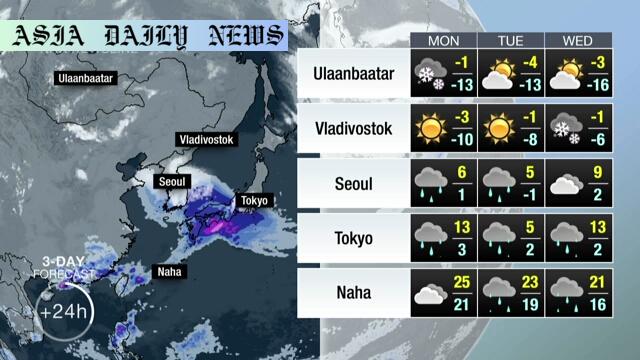Snow may accumulate in low-lying areas of the Kanto plains, disrupting transportation and leading to possible traffic issues.
Snow is predicted to accumulate in Tokyo and Kanto plains, disrupting transportation.
Up to 3cm of snow may fall in southern Kanto, with heavier accumulation in mountainous areas.
Travelers and residents are advised to use caution, monitor weather updates, and prepare for road and travel disruptions.
Regions along the Sea of Japan coast face additional risks of landslides due to melting snow.

Unseasonal Weather Reversals and Sudden Change
After experiencing balmy temperatures last weekend, Japan braces itself for a sharp return to winter. Sunday’s highs reached 27 degrees Celsius in some southern regions, including Miyazaki City in Kyushu. Central Tokyo’s weather, reflecting early spring warmth at 22.1 degrees Celsius, rapidly shifts toward potential snowfall and icy conditions. This abrupt switch underscores the importance of monitoring weather updates and being prepared for contrasting extremes, as Monday introduces sudden freezing challenges.
Snowfall Predictions and Impact in the Kanto Region
Weather officials have warned of significant snowfall in parts of Tokyo and the broader Kanto plains. Forecasts indicate up to three centimeters of snow could accumulate in low-lying southern Kanto regions, heavily affecting daily commutes. Mountainous areas of Kanto-Koshin are expected to see greater snowfall, with an accumulation of up to 25 centimeters in specific areas by Monday evening. Heavy snow could intensify transportation disruptions, especially on major road networks and rail systems. Commuters are strongly urged to remain cautious and ensure vehicles are equipped with snow tires or tire chains.
Safety Measures and Travel Preparations
Officials advocate several precautionary measures. Residents in affected regions should limit non-essential travel, prepare for delays, and follow weather bulletins closely. Mountainous communities at risk of heavier accumulations should secure properties and minimize exposure to the outdoors. Those driving through snowy areas must use equipment like tire chains and maintain safe speeds. Additionally, areas along the Sea of Japan coast, where snow from previous cold waves has accumulated, pose risks of landslides caused by melting snow, adding another layer of environmental concern.
Looking Ahead: Weather Developments Early Next Week
The low-pressure system responsible for the Monday snowfall will temporarily shift southward. However, it is projected to return by Tuesday afternoon, potentially escalating the snowfall in mountainous areas anew. By midweek, heavier snow could once again impact commutes and daily life across regions. This cyclical weather behavior highlights the ongoing unpredictability of this winter season. Residents are advised to stay weather-alert beyond Monday and anticipate extended periods of wintry conditions.
Commentary
Adapting to Weather Extremes in Urban Centers
The anticipated snowfall in Tokyo, one of the most urbanized regions in Japan, highlights the challenges posed by sudden weather reversals. Snow in metropolitan areas, while beautiful, introduces a variety of logistical and safety complexities. Tokyo’s efficient transportation systems, usually immune to minor disruptions, face potential delays and capacity challenges when temperatures drop below freezing. Residents and city services must adapt swiftly to ensure safety during these wintry conditions.
A Call for Preparedness in Vulnerable Regions
The advice from weather officials to use snow tires and avoid non-essential travel must be heeded. Winter gear, reliable heat sources, and emergency supplies take prominence yet again as unpredictable weather affects daily life. For low-lying areas unaccustomed to substantial snow accumulation, preparedness becomes essential to minimize hazards and disruptions. The advice also extends to businesses reliant on logistics, as snowbound roads may delay shipments and supplies.
Climate Patterns and Their Behavioral Impact
Fluctuating weather, from 27 degrees Celsius to expected snowfall, prompts larger discussions about climate dynamics in Japan. While this specific event is rooted in seasonal patterns rather than lasting climate change, it forces communities to rethink their relationships with weather unpredictability. Themes of resilience and adaptation emerge as central responses for Tokyoites and residents throughout the Kanto region. Institutions and households alike benefit by remaining vigilant and employing lessons from this unique weather situation.


